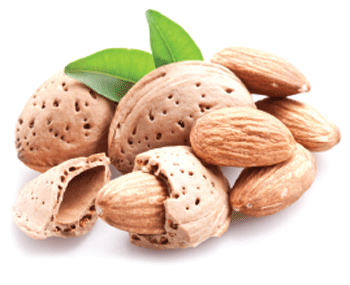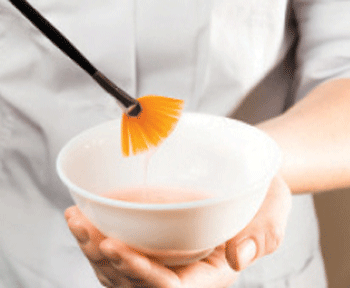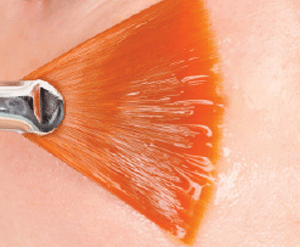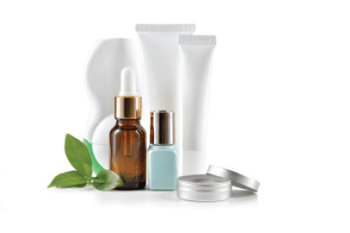The common term used in aesthetics is retention hyperkeratosis. Increased sebum production and proliferation of Propionibacterium acnes are also seen as causative or primary factors. Therefore, the common methods of addressing acne involve treatment with potent keratolytic and corneolytic ingredients, reducing sebum and controlling bacteria. By normal standards, P. acnes is not pathogenic in skin care because there is no association between the number of bacteria, severity, and type of acne.
Because of the importance placed on keratolytic and corneolytic action in acne treatment, peels are almost always implemented, except where corneotherapy principles or holistic skin care treatment modalities are used.
AN OVERVIEW OF PEELS
Superficial peels affect the stratum corneum, granular, squamous and basal layers. These include alpha hydroxy acids, retinoids, beta hydroxy acids, salicylic acid, and Jessner’s solution.
Alpha hydroxy acids are water-soluble carboxylic acids that work to dismantle the desmosomes. Alpha hydroxy acids can stimulate inflammation mediators
or cytokines.
When considering various hydroxy acids, molecular weight is important because this affects how rapidly it penetrates into the skin. For example, glycolic – 76; malic – 134; mandelic – 152; lactic – 90;tartaric – 150; citric – 192.
Glycolic Acid
Glycolic acid, which is derived from sugars, has a low molecular weight, making penetration rapid and often leading to potential irritation and inflammation; it is not recommend for inflammatory acne conditions. Glycolic is a strong degreasing agent and overuse causes deep dehydration. It is often used to normalize hyperkeratinization. The flipside to glycolic acid is that some studies suggest that it actually increases viable epidermal thickness, along with increasing dermal glycosaminoglycans.
 Malic Acid
Malic Acid
Malic acid is found in several fruits and vegetables, but its highest concentration comes from apples and cherries. It is best used for increasing oxygen supply and is rich in antioxidants. Malic acid is a natural humectant, drawing moisture out of the dermis and into the epidermis. This helps keep the skin hydrated without contributing to oiliness, but could this potentially be depleting reserves in the dermis?
Mandelic Acid
Mandelic acid, derived from bitter almonds, is becoming increasingly popular in acne treatment and for good reason. Mandelic acid is a unique lipophilic alpha hydroxy acid, giving it the ability to penetrate into the oil-filled follicles and breakdown the impaction or plug. It has a very large molecular structure (152); thus, it is much slower to penetrate the skin’s layers, allowing for a more even treatment and making it one of the gentlest alpha hydroxy acids, as long as the pH is not too low. Mandelic acid works in a very similar manner to salicylic acid, except that it cannot penetrate as deeply. Furthermore, it is a powerful antibacterial. Mandelic acid exhibited in vitro antibacterial activity against clinical isolates of MRSA. Mandelic acid is a beneficial ingredient in the treatment of adult acne and is an excellent option for preventing post-inflammatory hyperpigmentation.
Lactic Acid
Lactic acid is found in milk and sugars, as well as bilberry. Its larger molecular size allows it to penetrate slowly, reducing the chance of irritation and inflammation. Lactic acid also acts as an antimicrobial and suppresses tyrosinase formation, making it effective in preventing post-inflammatory hyperpigmentation.
Tartaric and Citric Acid
Other alpha hydroxy acids include tartaric and citric acids. Tartaric is found in grapes and gives wine its distinct taste; it is also found in other fruits, such as passion fruit. Tartaric acid has been shown to protect the skin from collagenase and elastase, which influences wound healing and scar formation, an important consideration in acne treatment. Citric acid increases hyaluronic acid in the skin and brightens it, but has also been shown to increase pigmentary issues.
Salicylic Acid
Salicylic acid is commonly the only beta hydroxy acid used in skin care. It is lipophilic, allowing it to work within the follicle. It normalizes excess inter-follicular cell shedding. It is both keratolytic and corneolytic, reducing impactions and microcomedone formation. A derivative of acetylsalicylic acid, it provides anti-inflammatory benefits. It may improve epidermal thickness, barrier functions, and collagen production. But it may also cause the skin to become thinner, sensitized, and dry.
Peel Depth
Medium-depth peels affect the papillary dermis and include 30 to 40 percent trichloroacetic acid and higher concentrations of Jessner’s solutions; these peels require medical supervision.
Deep depth peels include phenol peels, trichloroacetic acid above 40 percent, and laser resurfacing, such as Erb:YAG/CO2. These reach the reticular dermis and are performed by a physician. Trichloroacetic acid can be very aggressive. It is the result of a chlorine and acetic acid reaction. As it is a cauterant, trichloroacetic acid should be reserved for textural concerns such as deep scarring, meaning it breaks down living tissue. Medium-depth and deep-depth peels, if considered, should be held off as an option until active, acne lesions have cleared, then used to address scarring and post-inflammatory hyperpigmentation. However, these stronger peels remain popular in numerous clinics for active, acne treatment.
Superficial Frosting
Superficial frosting is a crystal residue that can be seen when performing some salicylic acid peels and can be wiped away, but should never be confused with blanching. Medium-depth and deeper peels performed by physicians often cause white protein coagulation known as blanching and can be the expected end point of trichloroacetic acid and phenol peels. Blanching should never be seen when performing superficial peels.
Neutralizations and Complications
Peels can be self-neutralizing or may require neutralization by thorough removal or the application of a solution such as sodium hydroxide. Self-neutralizing peels are neutralized by constituents of the skin and its water content.
Complications from peels can include edema, persistent erythema, pruritus, blistering, infections (including herpetic, bacterial, and candidal), milia, scarring, textural changes, hyperpigmentation and hypopigmentation, lines of demarcation, tissue injury, acneiform eruptions, and allergic reactions, although these more serious complications occur mostly in medium- to deep-
depth peels.
ENZYMES
Enzymes are essential to every living process. The body recognizes over 3,000 enzymes and diverse cells utilize specific types of enzymes. Enzymes can be derived from fruits, vegetables, marine life, and animals, although animal-sourced enzymes are not common in skin care.
Enzymes are the best and safest ways to exfoliate and they have proven to be of great benefit in acne treatment. They also help with pigmentary issues and promote an overall renewed skin surface.
Enzymes have protein and lipid-dissolving properties that dissolve or digest necrosed cells or dry, dead skin debris that is about to slough off, all while maintaining healthy skin and without creating any considerable pH alteration. Enzyme exfoliation is often improperly referred to as an enzyme peel, although enzymes do not peel the skin.
Enzymes eliminate excess cells, leaving the living, adhered cells intact. Protease enzymes, used for skin care are able to decompose human skin proteins like keratin. Along with the influence of heat and humidity, such as the use of a steamer or warm, moist towels, enzymes penetrate between comedone plug and follicular wall and loosen or partially dissolve the sebaceous and
cornoid amalgam.
Enzymes also defend the skin against the effects of free radicals and enable the skin to generate new cells. The most commonly-used enzymes in skin care are papain, derived from papaya; bromelain, derived from pineapple; and curbubita pepo, derived from pumpkin.
 TARGETING BIOFILMS
TARGETING BIOFILMS
Biofilms are thin, protected microenvironments or strongholds that bacteria develop to live, breed, and hide inside. The pink slime in a pet’s water dish is an example of a biofilm. In many cases, bacterial biofilms have been shown to contribute to long-term infections. P. acnes resides within the pilosebaceous unit in a biofilm. P. acnes forms biofilms characterized by increased lipase activity. Lipase generates irritant fatty acids that foster inflammation. Biofilms also cause keratinocytes to tenaciously stick together and bind to the infundibular epithelium. Antibiotics have a hard time penetrating a biofilm to kill the bacteria inside. Many plants and natural products have biofilm-fighting abilities as they have to defend themselves against bacterial invasion and therefore develop anti-biofilm compounds. Acids, retinoids, and reservatrol dissolve biofilms. Antimicrobial properties in manuka honey have shown activity against biofilms as well. Resveratrol inhibits matrix metalloproteinase, preventing the production of cyclooxygenase. Both manuka honey and resveratrol have potent antioxidant properties. These are just two examples of gentler, holistic options.
THE IMPORTANCE OF THE STRATUM CORNEUM
Most skin care professionals want to do away with dead skin cells and consider the stratum corneum dead. Therefore, they do not see an issue with ablating it. Corneotherapists and holistic skin care therapists see otherwise.
The famous dermatologist, Dr. Albert Kligman, who discovered Retin A, wrote the following: “In my paper of 1964, which established that the horny layer was a tissue made up of corneocytes, I could not have dreamed of the spectacular advances that have been brought to light by an international school of corneobiologists. I did not go any further than asserting that the stratum was a cellular barrier, the end product of a viable epidermis whose raison d’etre was to produce the dead stratum corneum... I did not have the vision to foresee that the stratum corneum would become very much alive.”
 The wonderful and essential epidermis is a full-of-life system of continuous proliferation and differentiation and has endless, crucial roles, including immunity, antioxidant, antimicrobial, and anti-inflammatory. The stratum corneum is of major significance for skin’s barrier function and actively contributes to skin’s stable equilibrium of physiological processes. Keratinocytes play an important role in the multiple homeostatic barrier responsibilities. They regulate immune and inflammatory responses of numerous cells such as Langerhans and endothelial cells and dermal fibroblasts. Stratum corneum cells have an immune function and inhibit the growth of microbes. The bottom line is that the stratum corneum is not dead; it is a functioning barrier and regulates
The wonderful and essential epidermis is a full-of-life system of continuous proliferation and differentiation and has endless, crucial roles, including immunity, antioxidant, antimicrobial, and anti-inflammatory. The stratum corneum is of major significance for skin’s barrier function and actively contributes to skin’s stable equilibrium of physiological processes. Keratinocytes play an important role in the multiple homeostatic barrier responsibilities. They regulate immune and inflammatory responses of numerous cells such as Langerhans and endothelial cells and dermal fibroblasts. Stratum corneum cells have an immune function and inhibit the growth of microbes. The bottom line is that the stratum corneum is not dead; it is a functioning barrier and regulates
key functions.
When the living cells of the epidermis are injured, messages are sent to the dermis that it is embattled. When under attack, the skin goes into an inflammatory response and inhibits all healthy skin functions. When there is less inflammation, there is less thinning. Aging occurs in the dermis. When the skin is stripped of its epidermal layer at an abnormal rate, a demand is created on the dermis to supply nutrients to the epidermis to help it repair itself. When treating acne, be mindful that the skin will also age. What effect is this treatment having on the long-term health and integrity of the skin?
Barrier disruption causes cytokines, such as interleukin-1, a pro-inflammatory, to be activated. Cytokines initiate the inflammatory cascade, including triggering endothelial cells and leading to further barrier disruption. This is a double-edged sword because skin disease, or in this case, acne, leads to barrier dysfunction and barrier dysfunction leads to skin disease. Furthermore, inflammatory cytokines produced by traumatized skin cause an upregulation of matrix metalloproteinases. This all further activates and sustains hypekeratinization.
Acne vulgaris exhibits greater transepidermal water loss and decreased stratum corneum hydration, which substantiates that the stratum corneum barrier impairment is associated with acne vulgaris. Acneic skin has significantly reduced free sphingosine and total ceramides in the stratum corneum, showing a deficient intercellular lipid tissue and impaired stratum corneum barrier. Studies support a correlation with barrier impairment and the severity of acne vulgaris. Additionally, loss of barrier integrity often occurs when the intensity of inflammation compromises the strength of the follicular wall.
 ACNE AS AN INFLAMMATORY SKIN DISEASE
ACNE AS AN INFLAMMATORY SKIN DISEASE
Disease is caused by inflammation and aging is induced by inflammation. Inflammation is associated with many skin diseases, such as eczema, psoriasis, and acne. There is plenty of evidence that demonstrates that inflammation is the basis of acne lesions. Inflammatory events not only precede hyperkertinization but also initiate and promote hyperkertinization. Inflammation is the trigger that sets off all the other events.
Studies show that inflammatory events are evident prior to hyperproliferation and abnormal differentiation. Interleukin-1, an inflammatory mediator, is elevated prior to hyperkeratinization. The consequences of that initial inflammatory damage then drive the pustule-formation process.
As sebum levels increase, linoleic acid decreases, causing a breakdown in barrier, which leads to an increase in interleukin-1, which causes inflammation. This is a vicious cycle of acne.
P. acnes does not directly cause significant damage to skin. Instead, most of the damage is due to the inflammatory process.
Removing dead skin cells without correcting the underlying pathology simply generates more skin cells. Inflammation is the root cause for hyperproliferation.
LIPID PEROXIDATION
Sebum is quantitatively, but more importantly, qualitatively different in acne because it has a significantly-decreased linoleic acid content. This issue perpetuates because when sebum increases, linoleic acid decreases. The end result is compromised follicle wall integrity. The degree of lipid peroxidation has a direct correlation to the amount of inflamed lesions. Inflamed lesions having a four-fold increase in lipid peroxide levels. Lipid peroxidation denotes the oxidative degradation of lipids. It is the progression in which free radicals steal electrons from the lipids in cell membranes, resulting in cell damage. Lipid peroxidation is the metabolic process in which reactive oxygen species result in the oxidative deterioration of lipids. Lipid peroxidation is evident in even the earliest microcomedones. It is to blame for comedogenesis and inflammation in acne. Antioxidants reduce the formation of peroxides and oxidation, thereby reducing and preventing acne; this is why they are such a crucial component in acne treatment arsenals. Sunflower oil is rich in linoleic acid (as long as it is high linoleic oil, not high oleic) and linolenic fatty acids, as is safflower oil. They both are beneficial in maintaining a healthy barrier, preventing microcomedones, and diminishing the effects of lipid peroxidation.
 CHOICES
CHOICES
The whole is often better than the sum of its parts. Bilberry, naseberry, willow bark, sweet birch (and other salix species), wintergreen, hibiscus, sugar cane, and sugar maple are all true and rich sources of all the hydroxy acids mentioned above. Whole-plant extracts or various elements can be found in many products and repeatedly demonstrate excellent efficacy. Plants contain not only acids, but also countless nutrients, enzymes, antioxidants, lipids, hyaluronic acid and humectants, proteins, omegas, peptides, and stem cells. They are often more effective and compatible with the skin as they are recognized and utilized by the skin.
Another excellent option that provides the benefit of the various alpha hydroxy acids or beta hydroxy acids, without the harshness of a peel, is the use of a serum containing active hydroxy acid at a lower percentage, alongside other potent antioxidant and anti-inflammatory active ingredients.
Over-treating the skin often triggers irritation and inflammation. Yet, removal of the epidermis by various means continues to be practiced in the skin care industry as the answer to acne, along with wrinkles, hyperpigmentation, and other skin conditions when these conditions really have little to do with dead skin cell buildup. Treating with high percentages of acids and other aggressive adjunct modalities time and again leads to post- inflammatory hyperpigmentation, perpetuates the acne breakout cycle due to the inflammatory cascade, and contributes to other complications. Professionals are forcing the skin to get faster results, but at what cost? Are aestheticians treating symptoms or supporting full skin health?
 Krista McKowen, a licensed aesthetician and instructor with a passion for wellness, has over 34 years of experience in the skin care industry, ranging from spa owner and medical spa director to writer and educator. Through a dedication and philosophy of creating beauty through skin health, McKowen has both a clinical and holistic background. Her expert knowledge stems from extensive and ongoing studies in cosmetic chemistry, massage therapy, aromatherapy, thallasotherapy, phytotherapy, health, and nutrition.
Krista McKowen, a licensed aesthetician and instructor with a passion for wellness, has over 34 years of experience in the skin care industry, ranging from spa owner and medical spa director to writer and educator. Through a dedication and philosophy of creating beauty through skin health, McKowen has both a clinical and holistic background. Her expert knowledge stems from extensive and ongoing studies in cosmetic chemistry, massage therapy, aromatherapy, thallasotherapy, phytotherapy, health, and nutrition.
Want to read more?
Subscribe to one of our monthly plans to continue reading this article.